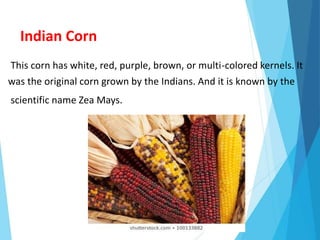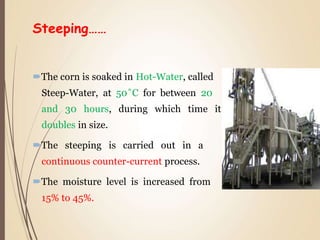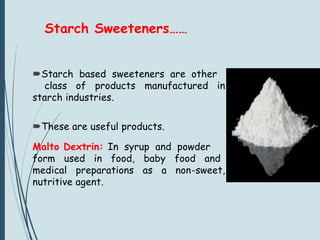Milling of corn.ppt
- 2. Corn (Maize) is one of the most versatile emerging crops having wider adaptability under varied agro- climatic conditions. Globally, maize is known as the queen of cereals because it has the highest genetic yield potential among the cereals.
- 3. As a cereal, maize is used as ingredient in food preparation; it is feed for poultry and livestock; it is feedstock for biofuel (ethanol); it is used as raw material in distilleries; and for starch production because of its high starch content. www.entrepreneurindia.co
- 4. STRUCTURE AND COMPOSITION C o m p o n e n t s o f Yellow Dent Corn Starch 61.0 % Corn Oil 3.8 % Protein 8.0 % Fiber 11.2 % Moisture 16.0 % The mature corn is composed of four major parts: Endosperm 82% Germ 12% Pericarp 5% Tip cap 1%
- 6. Corn Properties Approximately 20% of the Annual Corn Harvest is used to produce products such as Sweeteners, Starches, Oils, Ethanol and Animal Feeds. The remainder quantity is fed to Livestock, Poultry & Fish. Corn’s components are Starch (72%), Corn Oil (4.3 %), Protein (9.5%) and Fiber (9.5%). Approximately 16% of the Corn-Kernel’s weight is moisture.
- 7. Corn Starch Corn Oil Protein Fiber Moisture
- 8. Why Need of Corn A high potential business Contributes in food security Contains a lot of nutrients i.e. Folate, fiber etc Daily life contains maize directly or indirectly i.e. a huge proportion maize is used in feeding livestock A list of by products are produced
- 9. Types of Corn Corn, Zea Mays, is grown in most countries throughout the world and it require Warmer-Climate. Following are different kinds of corn, 1) DENT CORN 2) FLINT CORN 3) WAXY CORN 4) SWEET CORN 5) POP CORN 6) INDIAN CORN 7) FLOUR CORN
- 10. Dent Corn It contains both hard and soft starch and become indented at maturity, a major crop used to make food, animal feed, and industrial products and starch production
- 11. Flint Corn It has hard, horny, rounded, or short and flat kernels with the Soft and starchy endosperm. It is similar to Dent and is used for the Same Purposes. Most of it is grown in South America.
- 12. Waxy Corn WAXY corn is a corn variety with grains that have a waxy appearance when cut, and that contains only branched-chain starch. It is grown to make special starches for thickening foods.
- 13. Sweet Corn It is grown in many horticultural varieties, and is considered specific mutation of dent corn, it contain high sugar level at Milk-Stage when suitable for Table use.
- 14. Indian Corn This corn has white, red, purple, brown, or multi-colored kernels. It was the original corn grown by the Indians. And it is known by the scientific name Zea Mays.
- 15. Pop Corn It has small ears and rounded kernels which on exposure to dry heat, are popped or everted by the expulsion of the contained moisture, and form a white starchy mass many times the size of the original kernel.
- 16. Flour Corn It is composed almost entirely of soft starch. The USA grows small amounts of blue flour corn to make tortillas, chips, and baked goods.
- 17. Milling of Corn The basis of the maize milling process is the separation of the maize kernel into its different parts. Starch has been produced from corn for many years by two general procedures, namely 1. Dry milling 2. Wetmilling Both dry and wet milling procedures accomplish separation of the germ from which corn oil is obtained and removal of the hull which constitutes the majority of the high fiber portion.
- 18. Dry Milling Dry milling starches. refining processes provide less highly refined dry-milled products find use in many applications, such as in cereals, snack foods, pancake mixes, cookies, biscuits and in the brewing industry. It is a major object of this invention to provide a process for producing high purity starch from corn which eliminates the long steeping times normally required for wet milling production of starch.
- 19. The corn dry milling process is a less versatile, less capital intensive process that focuses primarily on the production of grain ethanol. The products of a traditional dry grind ethanol facility are fuel mainly ethanol and Dried Grains (DDG), a lowvalue animal feed product. Distillers
- 20. CORN DRY MILLING Dry milling process consists of the following steps: Cleaning Conditioning Degerming Drying Cooling Grading Grinding
- 21. Cleaning When corn is received at the mill, it is cleaned by both dry and wet process. Cleaning steps are sieving, separating particles by shape and density and removing ferromagnetic metals by permanent magnets. Conditioning The cleaned corn is conditioned, which basically means that water is added and the moisture allowed to equilibrate within the kernels. A moisture content of 21% is considered optimal.
- 22. Degermination The purpose of degerming is to remove hull, tip cap and germ and leave the endosprum into large grits. Drying The degermer product are to be dried to 15-18% moisture content for proper grinding and sifting. Drying is performed by conventional rotary steam tube dryers. Cooling Counter-flow or cross flow rotary cooler can be used for cooling the dried products.
- 23. Grading Recovery of various primary products is the next step. The through-stock is sifted or classified by particle size and enters into a conventional long reduction system having the function of removing bran and germ while releasing a maximum amount of clean large grits. Milling The milling operation consists of the steps of grinding, sifting, classifying, purifying, aspirating and in some case, final drying. The normal flow is through break rolls and then to sifters. The break rolls are followed by reduction roll which grind the endosperm to the desired particle size.
- 24. Wet-Milling Process…… This process is expensive as compare to Dry- Milling, and it requires more time, space, energy and waste treatment. It is designed to extract highest use and value of product low water consumption. The Corn-Wet Milling process is the industry standard, implemented in more than 170 plants around the world.
- 25. Principle The corn is steeped in an aqueous solution of Sulphur-Dioxide at a temperature of about 120° F or higher for extended periods of anywhere from 24 to 60 hours. The steep water is collected and concentrated for the recovery therefrom of soluble components. Softened corn is subjected to a series of grinding and separating operations to separate the corn kernel components, namely the Germ Hull Endosperm
- 26. Principle…… The mixture contain starch granules imbedded in a Proteinaceous matrix (gluten). For highly refined starch, additional separating procedures are necessary to separate the starch from Protein (Gluten). The remaining components then screened to remove fibre. In Centrifugation the mixture is separated to lighter Gluten and Heavier Starch.
- 27. Steps…… Following are the steps 1) CLEANING 2) STEEPING & SO2 ADDITION 3) GERM SEPARATION 4) FINE GRINDING & SCREENING 5) FIBRE DRYING
- 28. Steps…… 6) GLUTEN DRYING 7) STARCH REFINING 8) STARCH DRYING 9) MODIFICATION
- 29. Cleaning…… The Dent-Corn is supplied in bulk. First, we clean the shelled corn to ensure that they are free from dust and foreign bodies. The cleaning is normally done twice before wet processing.
- 30. Steeping…… The corn is soaked in Hot-Water, called Steep-Water, at 50˚C for between 20 and 30 hours, during which time it doubles in size. The steeping is carried out in a continuous counter-current process. The moisture level is increased from 15% to 45%.
- 31. SO2…… Sulphur dioxide is added to the water to prevent excessive bacterial growth like bacteria, moulds, fungi and yeast. It enhance the growth of favorable micro- organism like Lacto-Bacillus.
- 32. Water Evaporation…… The mixture is condensed on a multistage condenser and water is evaporated. Most organic acids which are formed during fermentation are also volatile and evaporated.
- 33. Wet-Milling Process…… The Steep-Water is not wasted. We concentrate it in an evaporator to capture nutrients, which are used for animal feed and fermentation.
- 34. Germ Separation…… The kernels are broken-up to loos the hull and break the bonds between germ and endosperm. Water is added to assist the wet milling. Corn germ contain 85% of corn oil. Germs then dried to 4% moisture level and oil can be extracted from germs. Recovery Cyclone
- 35. Milling……
- 36. Fine Grinding…… The remaining slurry is then subjected to fine grinding. This process release Starch and Gluten from fibre. The slurry flows over fixed concave screens which catch the fibre. But allow the starch and gluten to pass through.
- 37. Corn Fibre…… The collected fibre is dried for use in animal feed. Corn-Fibre
- 38. Starch-Gluten Separation…… The starch-gluten suspension passes through a centrifuge where the gluten, which is less dense than starch, is easily spun out. Gluten is then dried to 10% moisture and after hammering and processing it is sold as 60% Protein.
- 39. Starch Refining…… The purified starch milk is discharged to a peeler centrifuge for dewatering. The starch, which still has a small percentage of protein remaining, is washed to remove the last traces of protein and leave a 99.5% pure starch. Starch is among the purest of all agricultural products and purity makes it competitive.
- 40. Drying…… Starch is subjected to Flash Dryer and moisture level is reduced up to 12-13%. Before delivery the starch is screened on a fine sieve for impurities.
- 41. Modification…… The starch can either be dried and sold as corn starch, or it can be modified to turn into other products, such as corn sweeteners, corn syrups, dextrose and fructose. Many techniques are applies for modification for example 1. ph 2. Temperature 3. Additives addition
- 42. Germ Steeping Receipt Fiber Storage Cleaning Steeped corn Steeped water Hydro cyclones Degermination Slurry Fiber, starch, gluten Animal Feed Evaporation Corn steep liquor Corn Gluten Meal Oil Extraction Residues Impact Mill Starches & Gluten Centrifugation Gluten Starch Ethanol Production
- 44. The major products to be produced in the plant are: 1. Maize/ Corn Starch Sorbitol & Dextrose 2. Corn Flakes 3. Dextrose Powder 4. Maize Processing (Glucose, Sorbitol and Oil)
- 45. 5. Edible Corn Oil 6. Liquid Glucose From Maize 7. Corn Oil (Maize Oil) 8. Maize Processing Unit (Starch, Glucose, Gluten, Germ, Fiber, Steep Water) 9. Sorbitol 10. Wet Milling
- 46. Corn steep liquor The water drawn off the steeping process, known as light steep water Almost 6 percent of the original dry weight of the grain 35 to 40 percent is protein Steep water is sent to an evaporator where it is concentrated to 30 to 55 percent solid Residues of fiber milling are added in it Steep liquor is blended with fiber and corn gluten feed is prepared It can be sold wet or dried to extend shelf life
- 47. Corn Gluten Meal The extracted gluten is a protein-rich It is dried and sold for animal feed as gluten meal Contains about 60 % protein in it Used in poultry feed
- 49. Applications…… Being a pure renewable natural polymer, starch has a multitude of applications. Starch finds uses in fast food, sweets, sausages, tablets, and paper industry. Maize starch forms viscous, relatively short and opaque paste which stiffen the gel.
- 50. Applications…… In 2004 more than fifty percent of starch was converted to High Fructose Syrups (HFS). In textile industry, starch is used in sizing to strengthen fabric after it is bleached, dyed or printed. Now some By-Products of Maize-Processing are given below
- 51. Steep Liquor…… Corn Steep Liquor also known as condensed fermented corn. It is a high protein ingredient. It may be sold as 23% protein and 50% dry substance for cattle feeds. . Also it is a large source of biogas, which is being used as fuel for driers.
- 52. MAIZE GLUTEN…… Maize Gluten contains high protein content and it is used as cattle and poultry feeds. Corn Gluten Meal is the dried gluten from concentration. the gluten A typical yield per ton corn is 50 kg corn gluten meal with 60% protein.
- 53. MAIZE HUSK…… It contains starch, protein and fat as minor components and mainly consumed as cattle feed.
- 54. Starch Sweeteners…… Starch based sweeteners are other class of products manufactured in starch industries. These are useful products. Malto Dextrin: In syrup and powder form used in food, baby food and medical preparations as a non-sweet, nutritive agent.
- 55. Liquid Glucose: Widely used in the confectionary bakery, jam, canning and leather industries. Liquid Dextrose: In fermentation industries for the manufacture monohydrates, Sorbitol syrups. of dextrose fructose and
- 56. Applications…… High Maltose Syrup: As a malt replacement in brewing industry, in confectionary for Candy making.
- 57. Applications…… Liquid Sorbitol: It is hydrogenated dextrose syrup not having any reducing sugars widely used by tooth paste, pharmaceuticals, cosmetics and tobacco industries.
























































